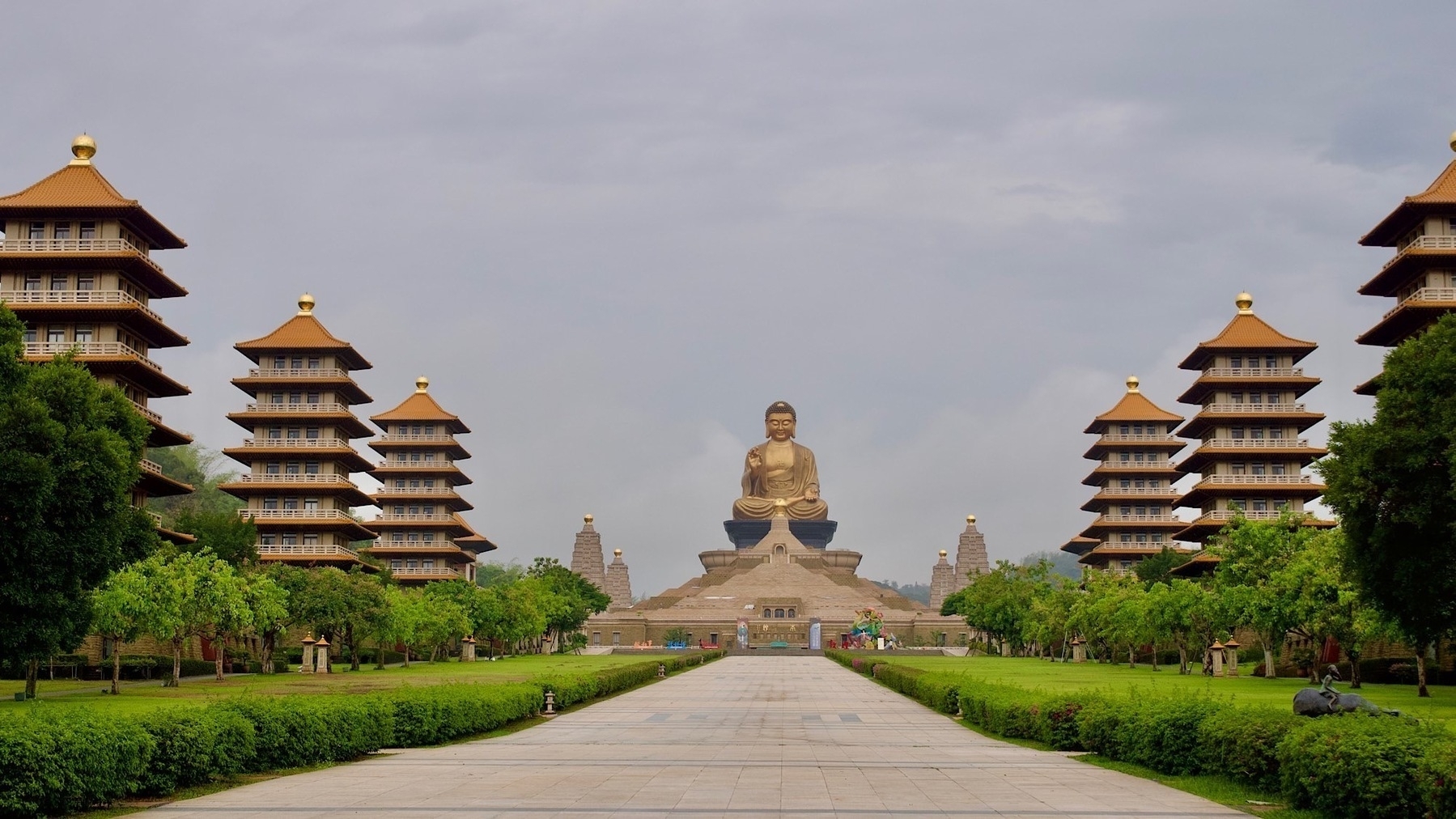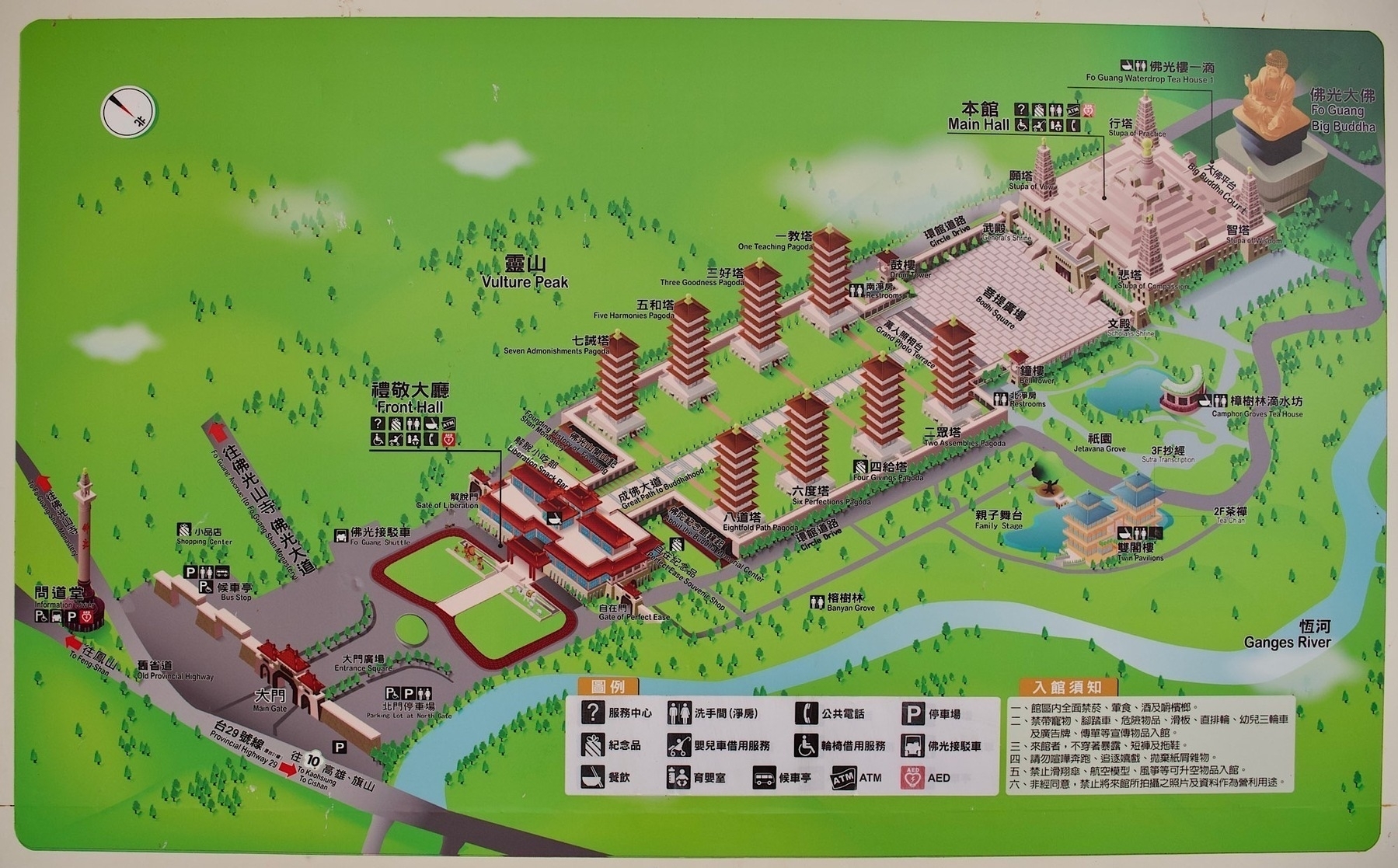Kaohsiung and Tainan, featuring Fo Guang Shan
This post is part of a series. See the introduction here →
(see the whole album in full screen on Flickr here)
Kaohsiung is a port city in southern Taiwan, developed by the Japanese as an important industrial hub. We hired a tour guide who carted us around to different locations including the port area, the old British consulate, the art walk, and to one of the most intensely nerdy coffee shops I have ever seen (run by what I am pretty sure are devotees of the Falun Gong new religious movement , check out the art to see what I mean).
Driving the streets of a non-capital city gives you another perspective into the lives of regular folk. I like just cruising and taking it in: a crowded row of store signs in bright Chinese characters pass by; students leaving university crossing the street as scooters wend past our vehicle to crowd the crosswalk; commuters in various Japanese and European cars; trucks hauling goods; glimpses down side streets as people take out their laundry or play basketball at the courts. Snapshots of lives. After the expertly brewed coffee came a sumptuous condensed-milk infused shaved ice topped with mangos and strawberries to cool off and consider all that was seen.
Fo Guang Shan

One highlight was visiting Fo Guang Shan (album) one of the four major temples of Taiwan, and home to a Buddha Tooth Relic, of which there remain only three in the world. This temple complex, built in the 1990s, is absolutely massive. Once you pass through the main entrance building which features an information center, a couple of restaurants, a bunch of souvenir stores, and a Starbucks, you are on a wide path lined by eight pagodas that leads to a main hall. Behind that hall is another building with a giant Buddha statue, overlooking the entire complex.

Each pagoda in itself is a museum of sorts. We went into just two: an information center with the history of the temple and teachings on the Noble Eightfold Path. The other pagoda we visited featured the One Stroke Calligraphy of Venerable Master Hsing Yun, the founder of Fo Guang Shan, who took up calligraphy after losing his sight — thereby restricting him to using just one stroke since he could not see where the characters were on the page.
We did not have time to peek into all of the pagodas, and since it was raining we followed the covered path that runs on the outer edges of the main route. Here we brushed our fingers along the dark stone walls, engraved with the names of every single person that donated money to the construction of this holy complex (photo). (We spotted a number of Japanese and English names too!)
Unfortunately photos were restricted in the main building. In the lobby I was able to take a shot of a carving of the 500 Arhats sculpted from roots of a 1000 year old camphor tree. Beyond that were a number of sub-shrines in this building. We navigated through groups of pilgrims and into the main temple dedicated to Guanyin (Kannon in Japanese). This was a very modern facility, circular with glass walls emblazoned with important religious figures, backlit by neon lights. The main altar featured a statue of 1000-hand Guanyin and some animatronics, and a line of small plastic bottles with red caps. At the direction of a helpful attendant, we paid our respects to Guanyin, and he filled one of the little bottles full of holy water from a dispenser in the altar. Later that night I poured some of the holy water over my head in the shower, and I think it worked! I never got sick the whole time in Taiwan, and I famously get sick on the fourth or fifth day whenever I travel abroad. We kept a few bottles to take home and put on our home altar as offerings to our ancestors.
Anyways, behind the circular shrine is a very square shrine with a heavy-looking gold statue of the Shakyamuni Buddha gifted from Thailand. This was another opulent room, which can be a little disorienting if you are used to understated Japanese temples. Next was the main show: the tooth relic. This large shrine room has a very high ceiling with wood panels carved in the images of famous Buddhist temples from around the world. I recognized Bodh Gaya right away. At the front of the room is a large Buddha, lying on one side, carved from white jade from Myanmar. Above is a little nook with the reliquary which contains the tooth. At the prompting of a nun, we each took a little battery powered candle and reverently walked up to the altar, placing it there as an offering. I just sat and stared for a while enjoying the ambiance until a large tour group came in — which is always my cue to leave.
The final area of the complex to see was the giant Buddha statue. We took a bunch of photos here, and circumambulated the Four Noble Truths Stupas on the four corners of the Main Hall, each shaped like the Mahabodhi Temple in Bodh Gaya. Symbolism is everywhere at Fo Guang Shan.
After this we took a very lovely vegetarian meal and browsed the shops. In all we spent just a few hours at Fo Guang Shan, but you could very well spend a couple of days here.
A few more spots around the south
Back from Fo Guang Shan we stayed at the Kaohsiung Grand Hotel (album), a much smaller (and ahem… cheaper) version of the Grand Hotel in Taipei.

Here we relaxed in the pool, I caught up on some writing, and we watched some local television. A Fo Guang Shan channel had a bunch of religious information. An “ethnic” channel featured indigenous programming in languages that sounded very different from the Mandarin and Hokkien we heard on the streets.
For our last day in the south we drove up to Tainan, about 45 minutes north with our guide where visited the large and newly made National Museum of Taiwan History. We spent as long as we possibly could until the kids were tired out learning about the full history of Taiwan from prehistoric times, the settlement of mainland Han Chinese, indigenous communities, repelling the Dutch, the Japanese era, the postwar economic miracle, and a bit about the issues facing Taiwanese today and in the near future. I took many notes, but to be honest the facility raised a lot more questions.
After the museum we rounded off our stay in the south by visiting the old Dutch fort (Chikhan Tower) and doing some shopping at the narrow Shennong Street before catching the High Speed Rail north to Taipei. Being the evening train on a holiday weekend, it was packed, so we had to stand for the one and half hour journey.
Next time, northern Taiwan! 🚅
